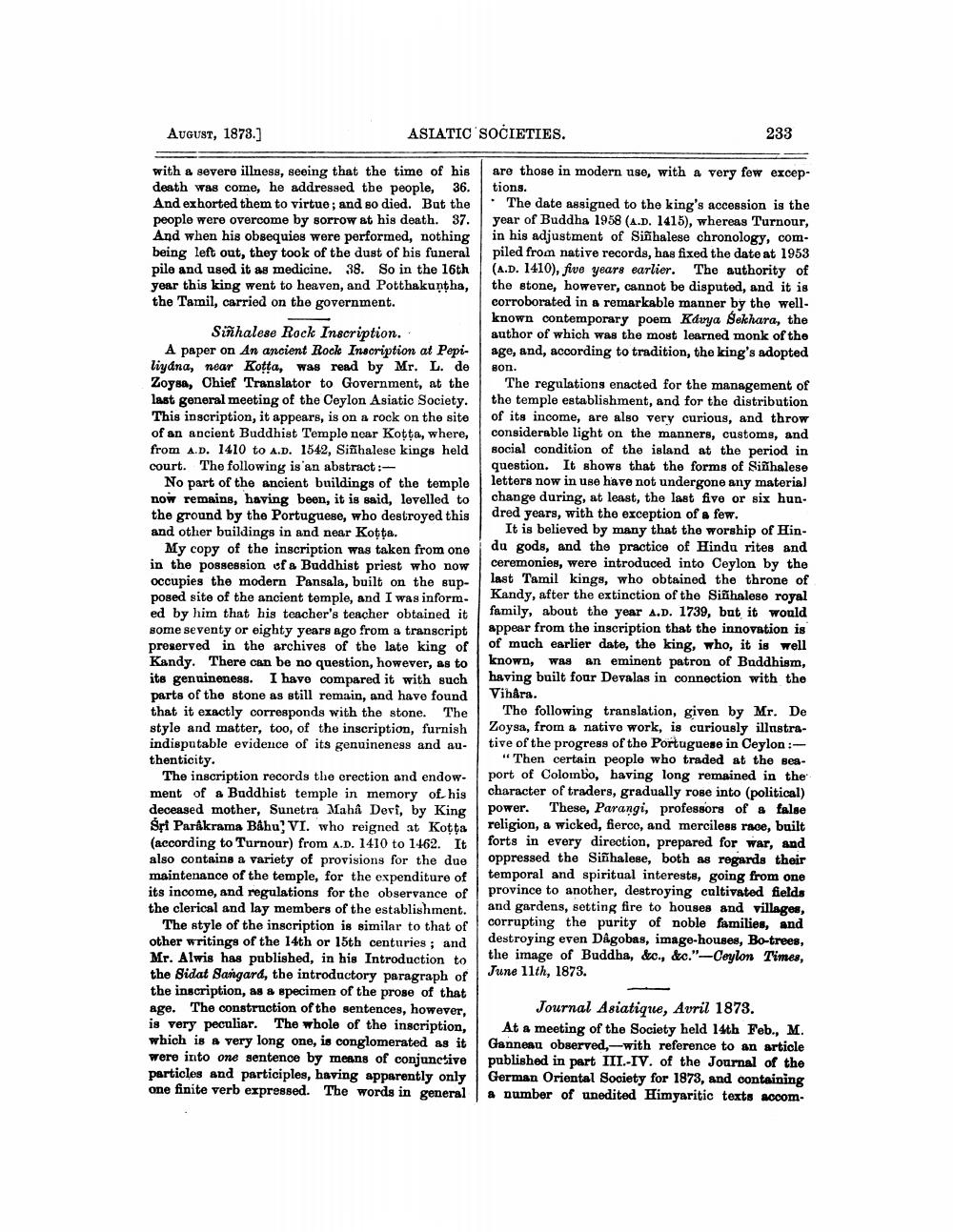________________
AUGUST, 1873.]
ASIATIC SOCIETIES.
233
with a severe illness, seeing that the time of his death was come, he addressed the people, 36. And exhorted them to virtue; and so died. But the people were overcome by sorrow at his death. 37. And when his obsequies were performed, nothing being left out, they took of the dust of his funeral pile and used it as medicine. 38. So in the 16th year this king went to heaven, and Potthakuntha, the Tamil, carried on the government.
Sinhalese Rock Inscription. A paper on An ancient Rock Inscription at Pepiliyána, near Kotta, was read by Mr. L. de Zoysa, Chief Translator to Government, at the last general meeting of the Ceylon Asiatic Society. This inscription, it appears, is on a rock on the site of an ancient Buddhist Temple ncar Kotta, where, from A.D. 1410 to A.D. 1542, Sinhalese kings held court. The following is an abstract:
No part of the ancient buildings of the temple now remains, having been, it is said, lovelled to the ground by the Portuguese, who destroyed this and other buildings in and near Kotta.
My copy of the inscription was taken from one in the possession of a Buddhist priest who now occupies the modern Pansala, built on the supposed site of the ancient temple, and I was informed by him that his teacher's teacher obtained it some seventy or eighty years ago from a transcript preserved in the archives of the late king of Kandy. There can be no question, however, as to its genuineness. I have compared it with such parts of the stone as still remain, and have found that it exactly corresponds with the stone. The style and matter, too, of the inscription, furnish indisputable evidence of its genuineness and authenticity.
The inscription records the crection and endow. ment of a Buddhist temple in memory of his deceased mother, Sunetra Maha Devi, by King Śrt Parikrama Bahu, VI. who reigned at Kotta (according to Turnour) from A.D. 1410 to 1462. It also contains a variety of provisions for the due maintenance of the temple, for the expenditure of its income, and regulations for the observance of the clerical and lay members of the establishment.
The style of the inscription is similar to that of other writings of the 14th or 15th centuries; and Mr. Alwis has published, in his Introduction to the sidat Sangard, the introductory paragraph of the inscription, as a specimen of the prose of that Age. The construction of the sentences, however, is very peculiar. The whole of the inscription, which is a very long one, is conglomerated as it were into one sentence by means of conjunctive particles and participles, having apparently only one finite verb expressed. The words in general
are those in modern use, with a very few exce tions.
The date assigned to the king's accession is the year of Buddha 1958 (A.D. 1415), whereas Turnour, in his adjustment of Sisihalese chronology, compiled from native records, has fixed the date at 1953 (A.D. 1410), five years earlier. The authority of the stone, however, cannot be disputed, and it is corroborated in a remarkable manner by the wellknown contemporary poem Kdvya Sekhara, the author of which was the most learned monk of the age, and, according to tradition, the king's adopted Bon.
The regulations enacted for the management of the temple establishment, and for the distribution of its income, are also very curious, and throw considerable light on the manners, customs, and social condition of the island at the period in question. It shows that the forms of Sinhalese letters now in use have not undergone any materia) change during, at least, the last five or six hun. dred years, with the exception of a few.
It is believed by many that the worship of Hindu gods, and the practice of Hindu rites and ceremonies, were introduced into Ceylon by the last Tamil kings, who obtained the throne of Kandy, after the extinction of the Sisihalese royal family, about the year A.D. 1739, but it would appear from the inscription that the innovation is of much earlier date, the king, who, it is well known, was an eminent patron of Buddhism, having built four Devalas in connection with the Vihåra.
The following translation, given by Mr. De Zoysa, from a native work, is curiously illustrative of the progress of the Portuguese in Ceylon :
"Then certain people who traded at the sea port of Colombo, having long remained in the character of traders, gradually rose into (political) power. These, Parangi, professors of a false religion, a wicked, fierce, and merciless race, built forts in every direction, prepared for war, and oppressed the Sisihalese, both as regards their temporal and spiritual interests, going from one province to another, destroying cultivated fields and gardens, setting fire to houses and villages, corrupting the purity of noble families, and destroying even Dagobas, image-houses, Bo-trees, the image of Buddha, &c., &c."-Ceylon Times, June 11th, 1873.
Journal Asiatique, Avril 1873. At a meeting of the Society held 14th Feb., M. Ganneau observed, with reference to an article published in part III-IV. of the Journal of the German Oriental Society for 1873, and containing a number of unedited Himyaritic texts accom




